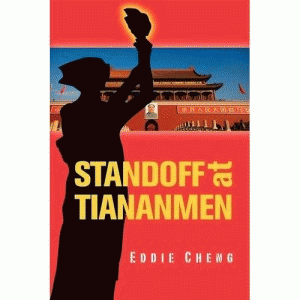Due to the impending 20th anniversary of the Tiananmen Square massacre in Beijing, China, it is very timely that author Eddie Cheng has published the new book, Standoff At Tiananmen.
With details never before seen in English, Standoff at Tiananmen is a riveting narrative, telling the story of the student-led pro-democracy movement which, in 1989, took over Tiananmen Square in the heart of Beijing, China -- until the Communist Party dictatorship struck back, using its army to clear the square.
While every history of the Chinese democracy movement is a partial history, this book has more detail about these matters than ever before in English. Tiananmen Square had world press attention, so that the largest features of the story became well known.
The Short Story
In the widely known version of events, former Chinese reform-minded leader Hu Yaobang died on April 15, 1989. The Chinese students chose to mourn him in a very public way, as a show of support for the pro-reform current of political thought. The earliest images beamed around the world may have been the flowers, wreaths, and portraits of Hu Yaobang, which were placed in the middle of Tiananmen Square to mourn his passing.
The widely known events include the April 22 funeral of Hu Yaobang; the April 26 editorial in the People's Daily condemning the students (and a huge march on April 27 that was a reply to the editorial); the May 13 - 19 hunger strike, with a visit by Soviet leader Mikhail Gorbachev on May 15; and the period of martial law from May 20 until the bitter end on June 3 - 4, when the massacre occurred. Also well remembered is the Goddess of Democracy, a 30 foot statue which appeared similar to the Statue of Liberty. The Goddess statue was unveiled on May 30 and stood until tanks knocked it down on June 4.
Â
Another widely known event happened afterwards, on June 5: One lone man stepped into the middle of Chang'an Avenue, to stop a line of tanks. The identity and fate of "the tank man" remains unknown, but his picture became an icon of 20th century resistance to communism.
Â
A Closer Look
--However, it is good to have deeper and lengthier historical accounts. Now, just in time for the 20th anniversary of these events, Eddie Cheng has published Standoff at Tiananmen, and it is a valuable contribution to the literature about Tiananmen Square. For average readers, the book is engaging and readable, and for those who care about details, it adds depth to previous accounts.
It is a blow-by-blow chronology of the action, but as I mentioned, every history of the Chinese democracy movement is a partial history. There are points left out by Eddie Cheng, and those points can be gleaned from other sources.
Cheng's book becomes a narrative of the students' side of the story, and of the politics and decision making on their side. To account for the other side Â- the power struggle and decision making inside the government Â- is left to be the scope of other books, such as The Tiananmen Papers.
That choice to limit the book's scope is fine with me Â- as a Generation Xer, on the side of the pro-democracy and anti-communist people, I believe that freedom is the right side of history, and I am most interested to have "our side" get its story straight.
Cheng was a Beijing University physics student beginning in 1980 and ending in 1986, when he left China. During the 1989 action, he could only watch on CNN just like the rest of the world public. But, he had remained friends with Liu Gang who was also in the physics department at Beijing University. Liu Gang had organized the "Democracy Salon" at Beijing University, a group that incubated student leaders of 1989.
(Note: You can view every article as one long page if you sign up as an Advocate Member, or higher).





